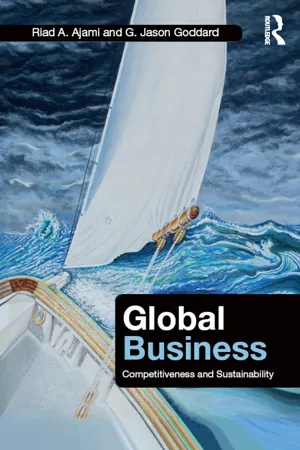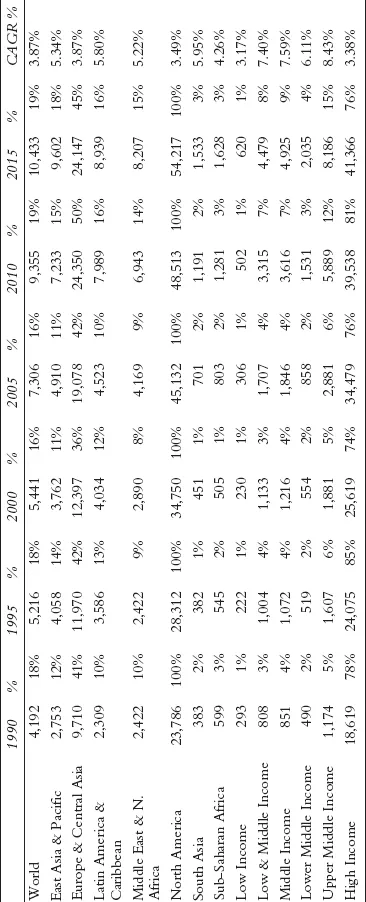![]()
1 Global business
Competitiveness and sustainability
I carry in my world that flourishes the worlds that have failed.
(Rabindranath Tagore)
Chapter objectives
This chapter will:
• Define the strategic orientation of this book
• Discuss the required shift in focus for global business educators
• Preview subsequent chapters and case studies
Introduction
Globalization has received much criticism in recent years. Populist rhetoric in the United States and Britain has joined forces with xenophobic political movements in Europe to present the case against the continued integration of world economies. At the heart of much of this rhetoric has been a focus on mass migratory flows of people across borders but globalization has also been blamed for the increase in inequality of incomes over the last decades.
Forgotten in this populist blitzkrieg have been the successes of globalization in contributing to rising wages in developing countries as well as rising standards of living in the developed world. Globalization begets global business as internationally active corporations have been the primary arbiter of global market penetration and the rise in global economic integration and inclusiveness.
When done correctly, global business can and does lead to a more sustained growth and provides benefits to consumers worldwide. Global business competition is generally good for consumers, as prices typically fall and quality typically rises, as sovereign consumers render their vote as to the winners and losers in the global marketplace by their purchasing decisions. Where global business has gone awry is when the profit motive comes before providing sustainable solutions for consumers. Rather than retreating from global market integration, it is the opinion expressed in this book that increased inclusion and promise are only possible when markets are integrated, when competition is free, and when sustainability is the overarching goal for the world economy.
Globalization: detractors and supporters
Given the reported retreat of globalization in recent years, it is worth reviewing just how successful market integration has been. Exhibit 1.1 shows world gross domestic product trends in five-year intervals from 1990 to 2015.
For ease of comparison, the compound annual growth rate over the period is shown at the far right of Exhibit 1.1. All areas of the world experienced positive GDP growth since 1990, with Asia, the Middle East and North Africa, and other developing areas of the world exhibiting a higher growth trajectory than world averages. High income areas such as in Europe and North America experienced growth less than world averages during this same time period. Based on the data shown in Exhibit 1.1, collective cognitive dissonance toward globalization in the developed world may have its origin in these slower relative growth rates. For workers displaced from their jobs owing to foreign competition, the temporary set-back could be ripe for anti-globalization sentiment.
Exhibit 1.2 takes a different view of the same time period. Rather than showing results based on GDP performance, Exhibit 1.2 shows world gross national income (GNI) per capita trends. The percentage column for each year illustrates how a particular region compares to the world average in terms of GNI per capita.
What this chart makes clear is that any cognitive dissonance regarding globalization experienced in the developed world is unfounded. While high income countries may have grown at slightly less than the world averages from 1990 to 2015, the dollar difference in per capita income is staggering when comparing high income countries with the rest of the world. Instead of globalization harming the lives of global citizenry, the figures in Exhibit 1.2 support the conclusion that a more sustainable level of growth is being experienced relative to the past. It should be noted that in Exhibit 1.1 the percentage of high income country GDP has fallen from 78% of the world total in 1990 to 64% of the world total in 2015. Viewed in light of the GNI per capita figures shown in Exhibit 1.2, this lesser share of world GDP by high income countries is hardly deleterious to citizens of the developed world. The analogy of “a rising tide raises all boats” seems most appropriate.
Exhibit 1.3 further supports the thesis that globalization promotes sustainability rather than disaffection. When foreign direct investment (FDI) inward stock is viewed from 1990 to 2015, global inclusiveness is clearly illustrated.
Other than China, which has received much higher foreign direct investment than world averages, the majority of regions are within a percentage point or two of the world average compound annual growth rate over the surveyed period. Based on this table, no area of the world is being ignored by economic integration and its effect has been continued and sustained growth in economies and per capita incomes. For those countries that have received large FDI inflows without the corresponding increase in economic performance, the fault lies not with globalization but with those local governments that are unable or unwilling to capitalize on the opportunities provided by economic integration. Now that we have debunked some primary arguments of the anti-globalization movement, we now turn to the primary focus of this book: success factors for globally active firms.
Exhibit 1.1 World gross domestic product trends 1990–2015 (World Bank, 2016)
Exhibit 1.2 World gross national income (GNI) per capita trends 19910–2015
(World Bank World Bank website link, 2016)
Exhibit 1.3 FDI inward stock by region and economy 1990–2015 (UNCTAD, 2016)
Note: Totals exclude the financial centres in the Caribbean
Global business: the balance of competitiveness and sustainability
Large market participants, such as the Norwegian Sovereign Wealth Fund, have increasingly made investment decisions based on how successful companies are in succeeding commercially while balancing growth with sustainability. Sustainability in our context is not simply an environmental concern, but it also must surely include considerations for product safety, consumer satisfaction, and consumer welfare.
The path to global market integration and commercial success is littered with pot-holes and occasional landmines. Sometimes initial smooth sailing for internationally active firms hits an unexpected resistance, such that it might appear that global economic participants are passengers on a rudderless ship. If the ship is truly without direction, then there is no need for a book such as this. If international expansion inevitably leads to tears, then there are no lessons to be learned from prior mistakes.
Problems in global business in part stem from the fact that global consumers tend to oscillate between desires for convergence and divergence. Convergence is defined as consumers desiring similar goods and services across the globe, while divergence is defined as local taste and preference differences globally. A world of convergence benefits multinational firms that sell similar products across the world. Exhibit 1.4 highlights the global consumer convergence spectrum that businesses face in the marketplace.
As some markets first experience the entry of global competitors, consumers may long for global convergence up until a tipping point is reached. When national cultural identities and institutions are threatened or replaced by the “global other”, consumers may retreat into desires of divergence: localism, nationalism, and cultural identity. During these retreats into divergence, the palpable benefits of globalization are conveniently forgotten.
How long the tipping point between convergence and divergence is delayed is a focal point of this book. In some ways, information technology is a leveler in this world, but at the same time there is multiplicity in functional approaches. Within the functions of a global business, there are decisions concerning the level of local responsiveness that is appropriate, realizing that this often contrasts with organizational efficiency.
Exhibit 1.5 illustrates a classic model focusing on global efficiency versus local responsiveness and flexibility.
Global efficiencies are cost savings and other synergies created by operating in different foreign markets. Local responsiveness and flexibility concerns the level to which a firm can respond to the divergent needs of its various markets. Typically the two goals are mutually exclusive, however the model does reveal that transnational corporations can be more apt to achieve high levels of global efficiency while also attaining a high level of local responsiveness and flexibility than other strategic orientations.
Exhibit 1.4 Global consumer convergence spectrum
Exhibit 1.5 Global efficiency vs. local responsiveness (adapted from Bartlett and Ghoshal, 1991)
Firms pursuing a transnational strategy attempt to maximize both local responsiveness and overall market integration by seeking the development and dispersion of innovation and knowledge within the entire network. Thus the multinational firm is seen as a network whereby each subsidiary is provided responsibility relative to its capabilities and strategic mission. The multinational's success is furthered by the movement of people within the firm that help facilitate the mutual development and dispersion of innovation and knowledge. In order to remain competitive, the transnational firm selects the strategic model that best fits the environmental pressures faced in order to remain competitive and successful.
Exhibit 1.5 shows that firms focusing on a global strategy typically achieve a high level of global efficiency but that the level of local market responsiveness tends to suffer relative to transnational corporations. For example, if a global business utilizes the global strategic orientation, then the typical mode of operation is to pursue market behavior that is successful in the majority of the markets where a firm competes. If those markets are materially diverse, then this strategic orientation can be problematic.
Some global firms that operate in highly divergent markets may pursue the multi-domestic strategy. This option tends to score highly in terms of local responsiveness and flexibility, as the needs of each foreign market are taken into account by the firm when competitive strategy is designed. This approach may be best for firms operating in diverse markets, but there is an associated cost as the benefits of global efficiency are not achieved using this approach.
The final global strategic alternative depicted in Exhibit 1.5 is home replication strategy. This strategic orientation is often employed by firms that are newly global. Firms that are entering foreign markets in order to sell excess inventory abroad may not take the time to cater their marketing and competitive positioning relative to the foreign market environment. This strategic orientation tends to score low on both global efficiency and local responsiveness and flexibility. Unless the foreign market is highly convergent with the home market, this approach is often not ...





